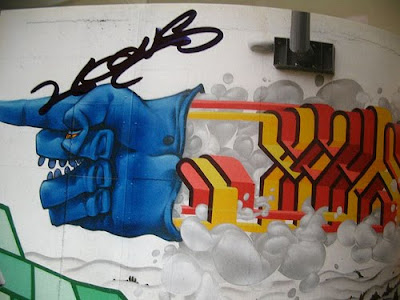
This time I will discuss a story or a history of graffiti. How graffiti writing was born and created. Actually, writing graffiti created by the writer from Poland by the artist named ARPONE in Graffiti-Workshop 'Europa 2001' in Vienna. To know more about this history please read the article below that I took from the Institute for Graffiti-Research (Mag. Schaefer-Wiery). The contents of the article is like this. (by http://guardian-graffiti-alphabet.blogspot.com)
The phenomenon, which we can observe all over the world, in colloquial speech, is called GRAFFITI. The beginning of this occurrence was taken place in New York on the turn of 60's and 70's. Since people from whole world have seen the first water resistant markers (called flow-masters), young people have been starting to write their own names or nicknames on the walls of buildings, postboxes, phone boxes, underground passages, and in the end on the subway. First of all it was called single hitting then tagging.
It was the time when some young people start to rival with the others through the writing own signatures. Probably the biggest collection of signatures had got guy named TAKI 183, who gave a interview to The New York Times newspaper in 1971.The real name of TAKI 183 was Demetrius. He was a young Greek who worked in NY as a boy for everything. Moreover he traveled a lot by a subway and during this time he was writing his tag's almost everywhere. Another well known writers from that period of time were: JOE 136, BARBARA 62, EEL 159, YANK 135, EVA 62.
In turn of 60's and 70's The MTA (Metropolitan Transit Authorities) had to spend over 300 000 dollars to remove subway. This amount was the equivalent of 80 000 working hours necessary to remove graffiti. However the writers not only were young kids. Also gangs to designate their territory and to become a famous used these forms of communication. Probably that was one of the most important facts, because after publishing an interview with TAKI 183, hundreds of kids start to write their names everywhere.
The names, which were written on the hardcore places very rapid, become famous and well known. And the owners of these signatures just day by day become heroes in their own local society. When the spray paint was invented graffiti had become more and more popular, besides more visible. After some time on the walls start to be missing free places and new tag's were invisible between some many others. It was necessity to begin new style, which would be more extravagant and of course unusual.
Throughout this time tags have become some kinds forms of artistic expression, new forms of graphics and logs that were characteristic for some writers. The letters has become more and more huge, with added of outline and connected with 'throw out'. That was the born of new form of graffiti called 'Piece'. It is the short version of word Masterpiece. In that time the most popular medium for graffiti was a subway. In 1973 The New York Magazine Newspaper throw open to competition for the best graffiti in the subway and admitted Tags award.
Styles were huger and added of third dimension, and 'throw out' in many new ways. So in the 1976 person called "Caine 1" painted first Whole Train, furthermore famous group named Fabulous Five painted the second one. In the same time young people worked very hard to create their own diverse styles. For the close the composition of letters added full stops, commas, inconvenient ways of union letters or deformation's letters. At that time were made o the most gorgeous and cults elements in graffiti. One of them was arrow, invented by Phase 2(he was also the inventor the bubble style).
The graphics' compositions that were made with letters weren't intelligible any longer. So this new technique created an innovative style called 'Wild Style'. Subsequently the background elements of graffiti were made and the new artists quiet fast adopted to develop them to their own styles. However almost everybody remembered about people who have experimented with sprays paints on the subway. This people were created the real manner of graffiti. For example Hondo created first top to bottom, Dead Leg-first top with clouds, Phase 2 -arrows, bubble style etc.
During this whole time the creations of thousands writers cost MTA hundreds millions of dollars. Generally speaking, between 1970-1980 The MTA had to spend about 100-150 millions of dollars to remove graffiti or to build securities systems etc. These amounts of money were spent, most of times, for unsuccessful tests of removing graffiti's. For example approximately cost of removing one quadrate meter is about 750 dollars, one whole car is about 78 000 dollars.
In the end of 1978 new system of removing whole cars were finally invented. It was water with specific chemises under huge pressure (it was called 'buff'). Only Blade lost in those days hundreds of his whole cars. However for the oldest cars called 'coffins' (that were built in the 50's) the buffing system didn't work perfectly. The system removed only parts of graffiti's. It seemed like coffins were dirtier than before. Painting on the new painted or buffed whole cars were for most of the writers the new challenge. Beyond this, the system worked more effective than any times before. By the way, MTA invested huge quantity of money to built securities systems in whole NY subway, for example MTA built five-meter high security fence with barbed wire.
The fact is, that security of NY subway have become more aggressive and violence and few writers were caught in and thrashing on dead. In case of that in 1978 writer Lee Quinones well known as Lee started to change their neighborhood. He changed the grimy place near Brooklyn Bridge into spectacular and incredible famous gallery of graffiti. He painted almost every night the walls next to a baseball fields, some people thought that it was an immense and very essential split in graffiti. The writers started to paint the walls not a subway.
Fab 5 Freddy was one of the people who were really interested in this occurrence. He wrote an article to Village Voice newspaper about this innovative transform in graffiti. In the same time Claudio Bruni, the owner of Medusa Gallery in Roma, arrived to New York He came on to find out the people who painted graffiti. Nevertheless Lee and Fred became first writers who have presented their artworks in Europe.
In 1983 Yaki Kornblit the tradesman of artwork from Amsterdam, came to New York and looked for the most talented writers. He wanted to present that kind of arts on the European market of artworks. He thought that it would like 20 years before when the Pop -Art were successful promoted in Europe. Yaki created group of experienced writers (who panted whole cars and take part in extremely important exhibitions in NY for example" Fashion Moda", The Mudd Club", "
The NY New Wave Show At P.S.I", " The Fun Gallery" and many others. In this Group were incredibly famous people such as Dondi, Crash, Ramellzee, Zephyr, Futura 2000, Quik, Lady Pink, Seen, Blade, and Bil Blast. The exhibitions of theirs artworks in Museum Boymans van Beuningen were an unbelievable success. The critics and collectors of art talked in positively way about their artworks. However it was not the end, this occurrence had deep meaning for development and promotion graffiti in Europe.
The young people from Holland were (and perhaps still are) very insubordinate and in that time on the street there were first signs of graffiti. In the similar time there was legendary meeting writers from NY with talented kids from Amsterdam of course in NY. It was the beginning of graffiti stage in Holland and also in the other parts of Europe.
In a consequence the writers started to divide for two different groups. The first one started to develop in a way to real art, to a new motives and inspirations. Their arts started to be more multiple, subtle and also well selling. Those writers, most of time, losing a contact with their previous publicity and the spray paint started to become one of many their painter's tools. The second groups were the writers connected with traditional paintings on the walls. This group focused more and more young people also connected with culture, which joined writers, breakers, rappers and DJ's. It was the graffiti culture of street.
On the beginning of 80's the Hip-Hop Culture had become more popular in USA and started developing in Europe. The most important thing is, that media promoted this culture. Thanks to them, and esp. legendaries films, and video clips or books whose described and promoted Hip-Hop many of young artists from New York become a stars. Such as Africa Bambata, The Rock Steady Crew, Phase 2, Futura 2000, Blade, Seen, Skeme, Dondi, or Lee. The style of Kase 2 (Computer Rock- who take part in film" Style Wars" or described in book "Subway Art") has become lately a pattern for young writers from Los Angeles or San Francisco.
In Spain B-boys are dreamed that they will have become the members of famous crew Africa Bambata-Zulu Nations in future. In Great Britain writers were painted the sign of Zulu almost everywhere. In many cities in Europe and in the USA graffiti become developing after the concert of Rock Steady Crew, because one of the members DOZE was the famous writer from NY. But the most significant for development graffiti art was the "Beat Street" film. Frankly speaking this film was huge Hollywood production, and has nothing common with real graffiti culture, moreover the 'throws out 'were painted by Hollywood scenographers whose have nothing ordinary with real writers. Nevertheless this film was an inspiration for many young people from whole over the world to painting, dancing and Dj-ing.
The first trains were painted in Wien, Dusseldorf, Munich, Copenhagen, Paris, London and Sydney but very seldom this kind of arts is well seen by some conservative people. This is connected with a specific situation in these cities. There were only few writers and their works were removed very quickly. Nevertheless European writers are focused on painting walls. Besides European people and writers from USA continue the NY style of artworks and trying to build up them in their own ways. 

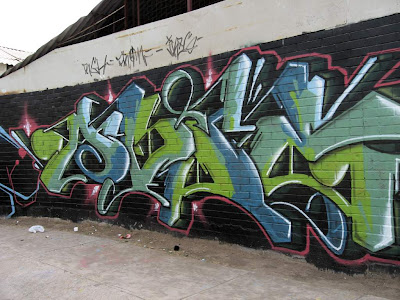

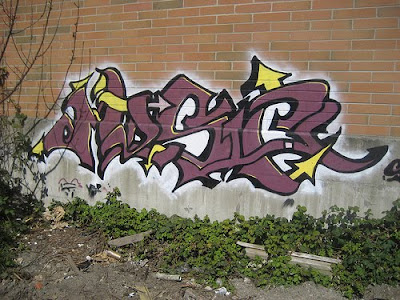
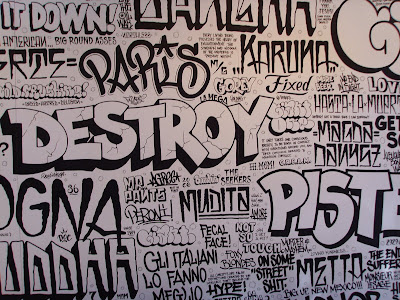

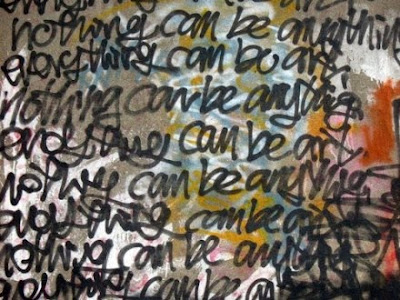
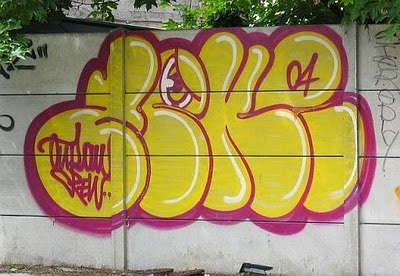



Please give your comments about this graffiti image, Thanks....
Saturday, February 5, 2011
The history of Graffiti-Writing from Institut for Graffiti-Research
Posted by admin on 12:13 AM



0 comments:
Post a Comment